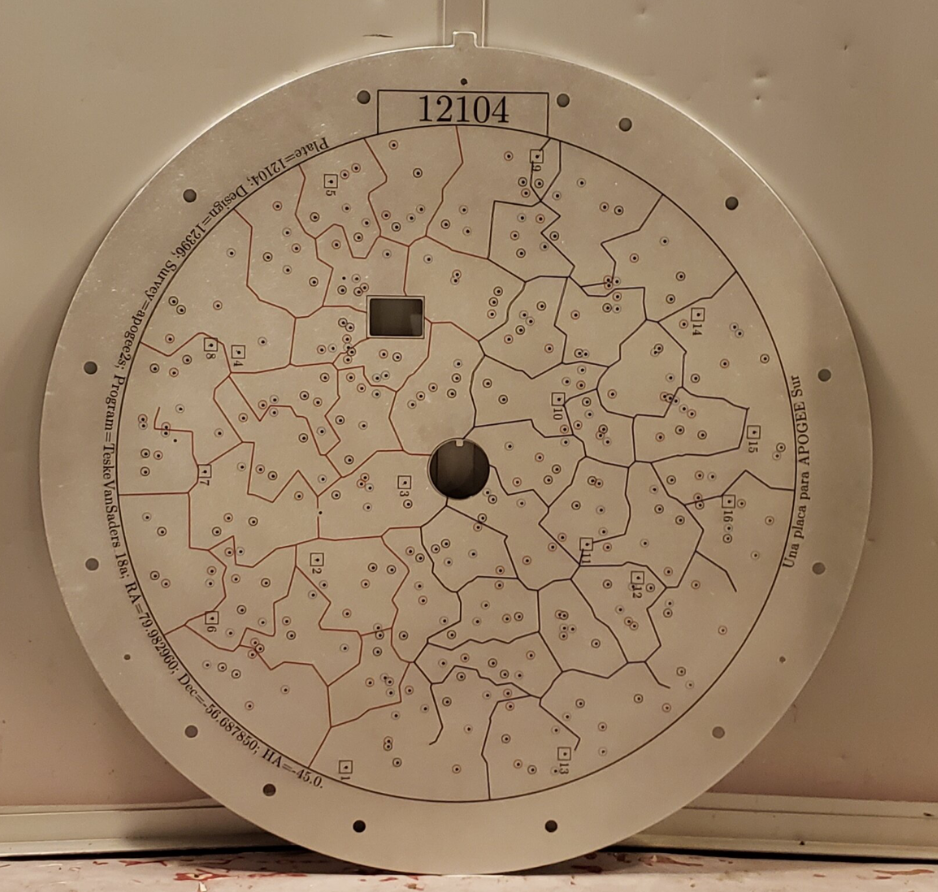Plates in the SDSS context are round pieces of aluminum with holes in them to plug the fibers that collect the light from each astrophysical object. From 1999 through 2021, SDSS used these plug plates to perform our observations. These plates needed to be designed and drilled with a few months in advance so that they can arrive on time to the telescope for the observations.
For the limited SDSS-V plate program (which included the eFEDS program released in DR18 but many other plates as well), we introduced a new hybrid BOSS+APOGEE observing mode – whereby each plug plate is simultaneously populated by a combination of 500 fibers leading to the BOSS spectrograph, and 300 fibers leading to the APOGEE spectrograph. This innovation was accompanied by a suite of procedural and software updates to manage the new plate design process.
In the SDSS-V plate era, each observing run consists of a list of plates planned for observation. Each plate is created to observe a set of targets from a given field (a region of the sky), and it is drilled to observe around a specific hour angle to account for atmospheric refraction effects. Then, the targets a plate were assigned using a specific combination of cartons (see MWM cartons and BHM cartons) which correspond to sets of targets with a specific science goal selected with a single selection algorithm. For each plate, we created a prioritized list of cartons to fill the fibers for each spectrograph. This means that to fill APOGEE and BOSS fibers we covered the corresponding list of cartons in priority order until all fibers for each instrument were filled. This fiber filling rule was shared by multiple plates in the same observing run or even across different runs, but one shift in priority of a carton with respect to another or an update on the version of the carton that was used implies a different fiber filling rule. Each combination of fiber filling rule and field of a plate (i.e. unique set of targets) was identified with a design id.
There were some differences in the early plate program sky and standard calibrations for APOGEE observations. In the case of APOGEE standards, the first plateruns from the plate-era used the same selection method as the one used in SDSS-IV/APOGEE (Zasowski, et al. 2017), which are flagged as coming from the “hacked” carton ops_std_2mass (and have the SDSSV_APOGEE_TARGET0=3 bit flag set), but are not included in the targeting database as an actual carton. Then, for the later stages of plate-era and the FPS-era we started using carton ops_std_apogee. In the case of APOGEE skies, we used the same selection method as in SDSS-IV/APOGEE (Zasowski, et al. 2017), which are flagged as coming from the “hacked” carton ops_sky_2mass, which have SDSSV_APOGEE_TARGET0=2 bit flag, but are not included in the targeting database as an actual carton. Then we replaced this carton with ops_sky_apogee to select apogee skies. Details about all these cartons can be found in Sky Calibration and Standards Calibration.
Finally, some bright objects in the SDSS-V plate program were observed “offset” to avoid the bright limits. These cases are indicated in the GRI_GAIA_TRANSFORM bitmask associated with the object (with the bit 20 set). For these objects, their spectrophotometry will be unreliable.

Example of an SDSS-IV APOGEE South plate. Small holes spread through the entire plate correspond to the places were fibers are plugged, medium size holes at the edges of the plate are drilled to fix the plate to the focal plane while the larger 2 holes were drilled to place acquisition cameras in SDSS-IV but those are not used anymore. Photo by R. Beaton.
